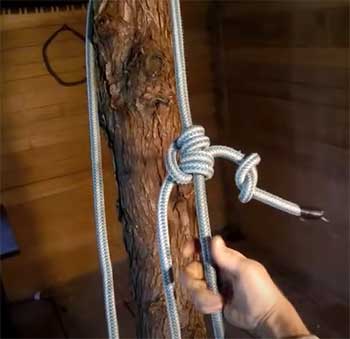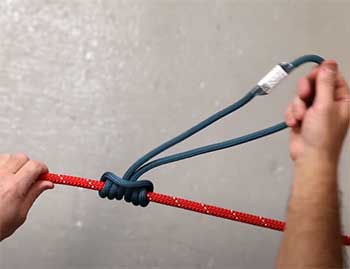Every climber needs to get ahold of a good-quality friction hitch. But there are so many options that need to be clarified, especially when you’re a newbie.
The good news is that a few classics always stand out in the crowd, even with such a populated choice list, just like the age-old Prusik and Blake’s hitch.
This article will count down their differences, uses, and key features so you can make a wise decision. So, let’s dive in!
A Quick Comparison Table
Key Differences Between Prusik And Blake’s Hitch
- Adjustments

We all know the adjustment and fit of hitches are integral for climbers and adventurers.
Users who’ve used Prusik and Blake’s were quick to point out that Blake’s hitches were easier to adjust as it doesn’t lock as tight as the other.
Furthermore, it only allows a one-way knot which also means that it accommodates the one-way operation.
On the other hand, Prusik comes with a tighter lock, which can be tricky for users to adjust. This tighter lock eventually means that it’s a two-way know.
Thus, it can work in either direction.
Since Blake’s hitch is easily adjustable, it’s also wiser to curve down the first two bends while the thumb is inserted upwards along the rope, making it simpler to thread along the line.
Also Read: Differences Between Curt And B&W Gooseneck Hitch.
- Compatibility
Another feature that can’t be compromised is the compatibility of each of these knots with other ropes and lines. For example, Blake’s hitch is best used with the arborist rope.
However, Blake’s knot is around 11mm, which can be a bit bulky for many users. Additionally, if you use the 9mm Blake’s static rope, it might work inadequately.
On the other hand, the Prusik hitch is quite basic and, thus, works best with basic climbs without extreme heights. Furthermore, it was observed that Prusik performs best with emergency climbers or for those working in search and rescue teams.
With the Prusik hitch, users get the most advantage if utilized alongside 7/16″ ropes for 7mm cords and 1/2″ ropes for 8mm cords.
- Uses
Blake’s hitch is a grip, slide, and friction knot, which arborists can get the most out of while ascending or descending. Like any other grip or slide knot, arborists must exert the strains on the line beneath the hitch.
However, it shouldn’t be used for tractions, as pulling or holding the knot directly might loosen it, leading to loss of control and unexpected events, hazards, and accidents.
In contrast, the Prusik is also a friction knot best used when engaged with cord loops around ropes during zip lining, rescues, caving, mountaineering, canyoneering, and climbing.
- Performance

Let’s face it none of these knots make a sophisticated climbing experience.
However, Blake’s hitch has one satisfactory feature: it sets itself apart from any other friction hitches in the history of hitches.
It can function in an unparalleled, top-tier manner on ropes with equal diameters and the cords utilized to tie them.
And no arborist must climb without knowing these advantageous features as in case of emergencies; they may need to stop and set up the three-knot mechanism while descending.
Some users also incorporate minor levels of rigging for a progressive capture in the system and a stopper knot for PPEs, but those are just other ways that Blake’s hitch comes in handy.
Although one downfall with Blake’s hitch is that users find it too sturdy, hear, and irresponsive during their climbs, which doesn’t bode well with everyone. Additionally, this also increases the frequency and chances of wear and tear of the ropes.
In contrast, the Prusik, even when you learn to tie it, you should avoid working at significant heights. Some variations like the Purcell Prusik may accompany well during search and rescues and mountain climbers; however, the traditional one still holds preliminary usage levels during ascending and descending.
Which Hitch Is Better For You?
Time to tell you the real deal by revealing which one we support. Which one should you pick for your next adventure? Well, there’s no easy way to choose one blindly.
However, we would go with Blake’s hitch simply because of its incredibly straightforward feature, top-notch performance, easy-to-use ways, and the fact that it has been tested throughout the years without any evident failure.
Nevertheless, users must understand their specific needs, the rope and cordage relationship, and the adventure they’re about to embark upon and then opt for the best-fit hitch as their safety is an utmost priority.
Moreover, before jumping on the bandwagon, one must also commit to practicing before the big day.
Also Read: Differences Between Titan And Summit Goliath Climbing Tree Stands.
Frequently Asked Questions (FAQ)
Conclusion
To be fair, this Blake’s and Prusik hitch comparison would be useless if users don’t match their needs to each of these classic knots’ usability. Throughout time, Pruski and Blake’s hitch have proven themselves worthy.
However, there’s no denying that it requires practice and proper use with complementary products. With that being said, once you understand which of these hitches is best for your use, there’s no stopping you, whether it’s extreme heights or generic search and rescue.
Good luck!









